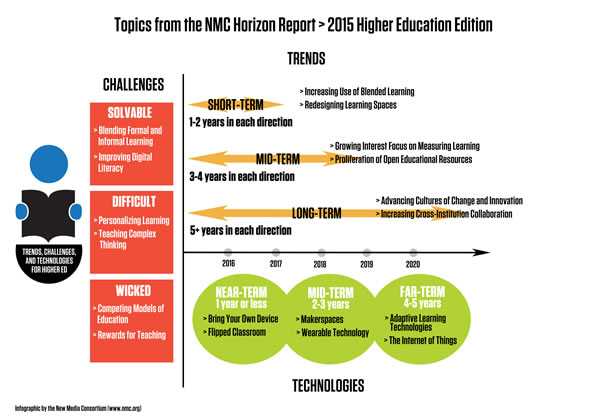NMC and EDUCUASE release the 2015 Horizon Report, outlining 18 trends in higher-ed technology over the next 1 to 5 years.
 [Editor’s note: Based off of Google Analytics, this story was our seventh most popular article. It was originally published on Feb. 9, 2015.]
[Editor’s note: Based off of Google Analytics, this story was our seventh most popular article. It was originally published on Feb. 9, 2015.]
“Makerspaces” will gain traction long before adaptive learning; and improving digital literacy is a breeze compared to determining how to reward educators for teaching.
These are just two of the findings released as part of the New Media Consortium’s (NMC) 2015 Higher Education Horizon Report, jointly conducted with the EDUCAUSE Learning Initiative. The Report charts the five-year horizon for the impact of emerging technology in learning around the world.
In existence for over a decade and consisting of a panel of 56 tech experts from 17 different countries, the Horizon Report for higher ed identifies 6 key trends,6 significant challenges, and 6 important developments in educational technology across three adoption horizons over the next one to five years.
The Report is derived from three meta-dimensions that “were used to focus the discussions of each trend and challenge: policy, leadership, and practice,” it explains.
For 2015, “the experts agreed on two long-term trends: advancing learning environments that are flexible and drive innovation, as well as increasing the collaboration that takes place between higher education institutions,” says the Report.
In identifying “challenges” for universities and colleges, improving digital literacy is considered one of the most “solvable” challenges, as it is already being addressed by individual universities. For example, the Open University (UK) has developed the “Digital and Information Framework” to standardize and implement better digital literacy training in their curriculum; and Cornell University (U.S.) has also made available online resources for learning key tech skills.
However, the Report’s experts said that some challenges were especially “wicked”, such as rewarding teachers for innovative and effective pedagogy, since this challenge is “one that is impossible to define, let alone solve. Many institutions provide more incentives for research over exemplary teaching.”
(Next page: Technology and innovation trends on the horizon; infographic)
Trends
Short term (1-2 years):
Mid-term (3-4 years):
Long-term (5+ years):
Emerging Technologies
Near-term (1 year or less):
Mid-term (2-3 years):
Far-term (4-5 years):
Challenges
Solvable
Difficult
Wicked
Infographic
Each topic is further defined and explained in context within the Report. Each also closes with an annotated list of suggested readings and additional examples that expand on the discussion. These resources, along with other readings, can be found in the project’s open content database that is accessible via the free NMC Horizon EdTech Weekly App for iOS and Android devices.
All the background materials for the Report, including the research data, preliminary selections, topic preview and more can be downloaded free on iTunesU.
The Report will be published in full Wednesday, February 11th, here: http://go.nmc.org/2015-hied
NMC and EDUCAUSE say it is their hope that this research will “help to inform the choices that institutions are making about technology to improve, support, or extend teaching, learning, and creative inquiry in higher education across the globe.”
- 25 education trends for 2018 - January 1, 2018
- IT #1: 6 essential technologies on the higher ed horizon - December 27, 2017
- #3: 3 big ways today’s college students are different from just a decade ago - December 27, 2017

